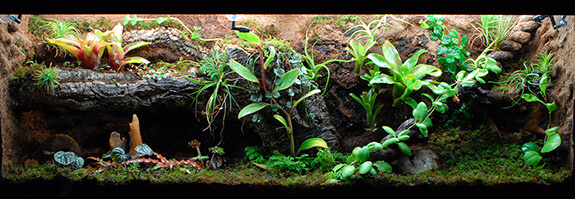Plants in the Lizard Terrarium
Table of Contents
Terrarium plants do not only perform a decorative function. They also influence the microclimate, provide the lizards with cover, and create a visual screen, thus establishing the territories that are necessary for many types of lizards.

Important note: Some of the plants described have juices that can be injurious to health if they come into contact with the skin or mucous membranes of humans. After work with plants, wash your hands thoroughly, rinse away any juices from leaves or stems that have sprayed onto your face, and never put any portion of a plant into your mouth. Warn children about this!
Location of the Planted Terrarium
Light is necessary for plant life. It is essential for the production of chlorophyll, which in turn is a requirement for plant vigor. If there is too little light available, the plant will try to grow toward it. It produces longer and thinner shoots with pale little leaves, and the plant yellows. The plant can only compensate in this fashion for a very short time, because not enough chlorophyll is being created; the plant is “starving” in spite of the nutrient-rich soil.
You must therefore choose the brightest possible location for a planted terrarium. If some of the plants continue to show signs of lack of light, they should be removed from the terrarium and placed in a very bright spot or on a balcony for a while.
Planting Medium
The planting medium for terrarium plants is leafmold or decayed pine needles. If the depth is greater than 0.2 inches (5 cm), provide a drainage layer of gravel or broken flower pots. Then the water can trickle through the dry earth and collect in the pebble or crockery layer. A floor of heavy clay or humus becomes waterlogged easily and in dry periods will become hard and cracked.
Many terrarium plants grow as epiphytes, or air plants; they are planted as follows: Free the root ball of the dry soil, pack it into sphagnum moss, coconut fiber, fern roots, or other plant material that drains readily, and press it into the fork of an epiphyte support or tie or nail it to a branch. Air plants can also be stuck in a suitably large hole in a branch or a crack. Wherever you put it, the water must be able to drain off easily; epiphytes have adapted to this way of living to avoid standing water.
Watering
For watering use only clean rainwater or salt-free water that you can buy or produce yourself with an ion-exchanger (pet store). The use of salt-free water is essential for the culture of Tillandsia and other bromeliads with scaly leaves. The silver-white scales of the bromeliads function to take up moisture and nutrients. If they are encrusted with salts they can no longer do so. When salt-free water is used, such deposits do not build up on the leaves of the terrarium plants.
Plant Pests
No sprays or insecticides should be used in the terrarium! Try to wipe away leaf aphids, woolly apple aphids, and scale with a soft, damp cloth or a sponge. And increase the humidity, since these insects thrive in a setting that is too dry. If the noxious insects are still tenacious, there is nothing to do but remove the affected plants from the terrarium. Now you can use an insecticide. Afterwards wait at least two, and better four weeks before replacing them in the terrarium, and keep rinsing them off! If you continue having repeated attacks of pests, the only sure remedy is to change to another kind of plant.
Changing Plants
Plants that get too little light or are attacked by insects must be removed from the terrarium. You'll make the removal easier if you leave the plants in pots and sink them into the floor material deeply enough so that the tops are no longer visible. You should also transfer a plant if it needs cutting back or if the new shoots are in danger from the lizards.
Tip: If you want to use the occasion of the removal to fertilize, use bone meal or dehydrated manure according to the directions on the package.
Choosing Plants
It isn't necessary for the lizard's well-being that the plants come from the same area that they do. But many terrarium enthusiasts find it fun to create geographical unity between animals and planting. For this reason, this discussion of plants is arranged according to their range of distribution. If you would like to know more about terrarium plants, you can read about them in the literature.
Make sure when you buy terrarium plants that they are strong enough for your lizards. Will they survive a leap, for instance, or tightly clinging sharp claws? Please read the advice in the plant descriptions (below). It generally holds true that hard-leaved, dark green plants are less delicate than tender-leaved, bright green or even colored-leaved types. In choosing terrarium plants, always consider the effects of the heat, lighting, and UV lamps.




Leave a Reply